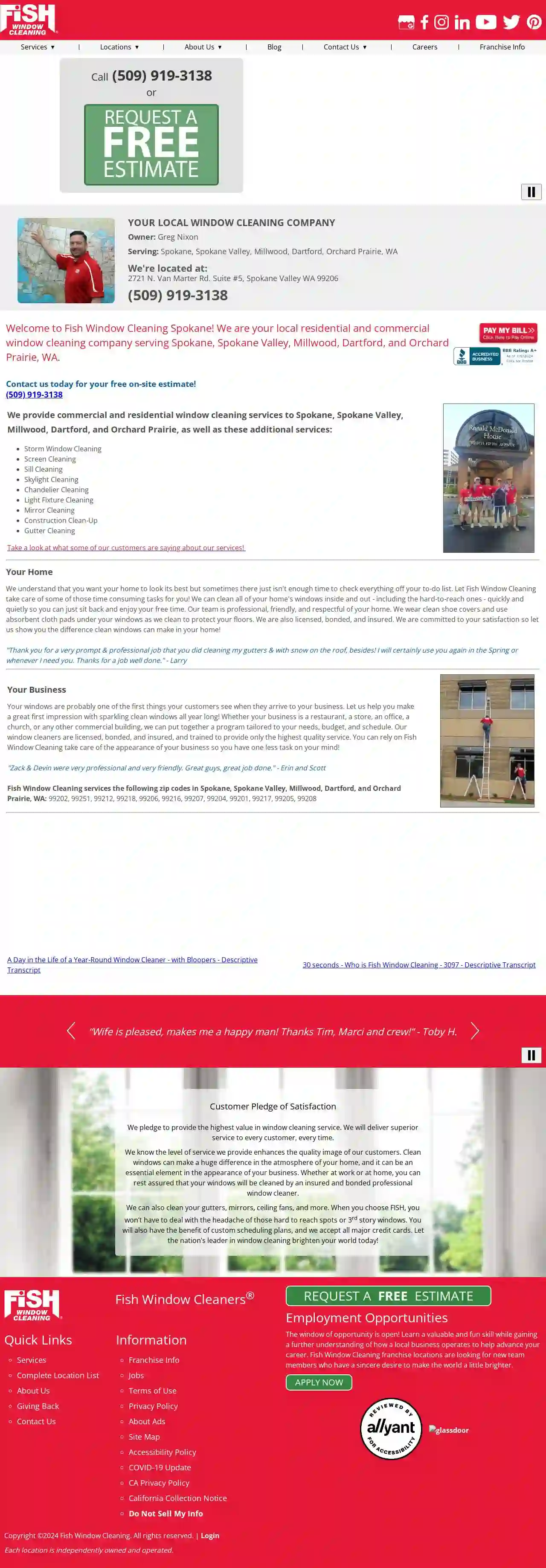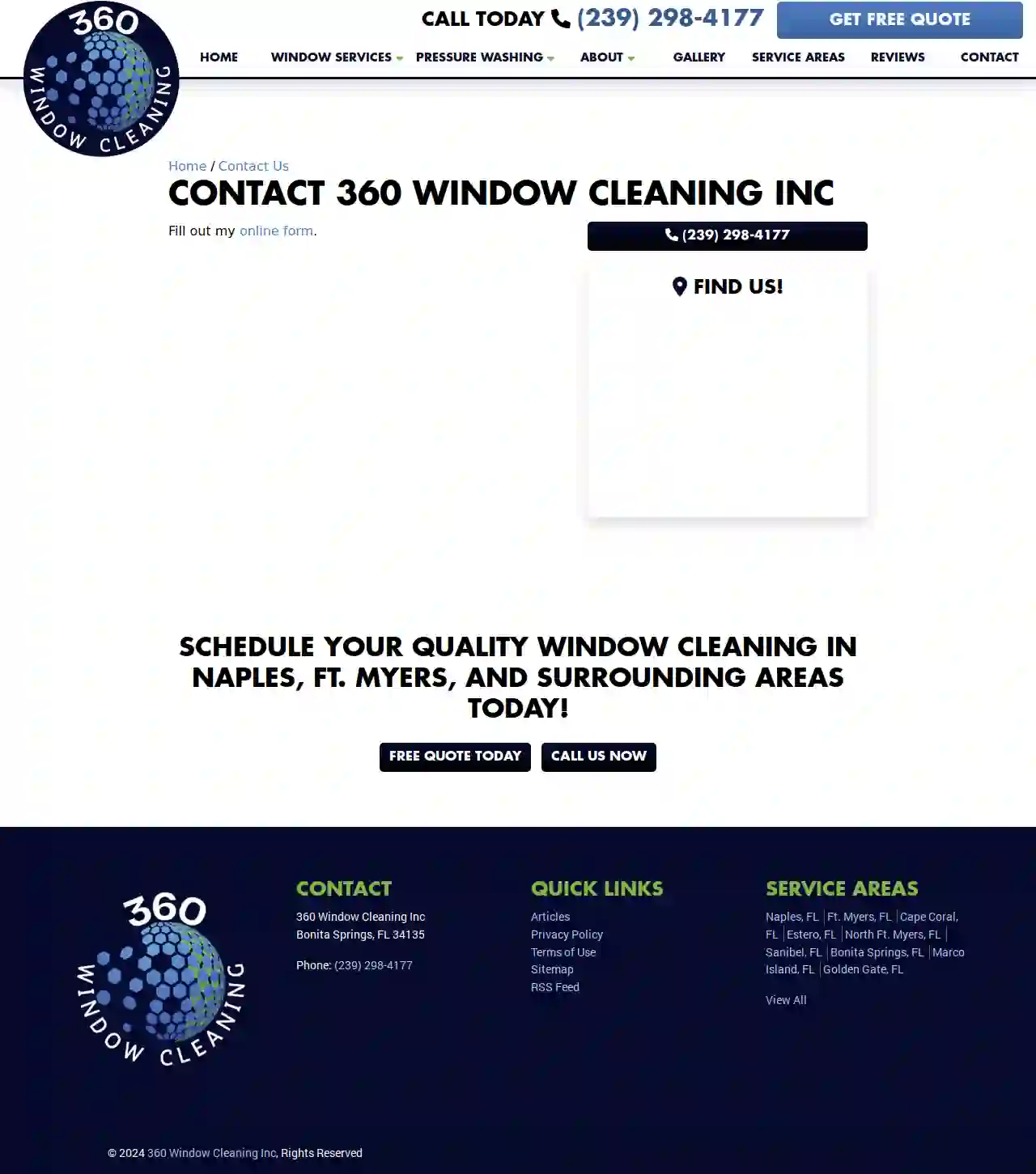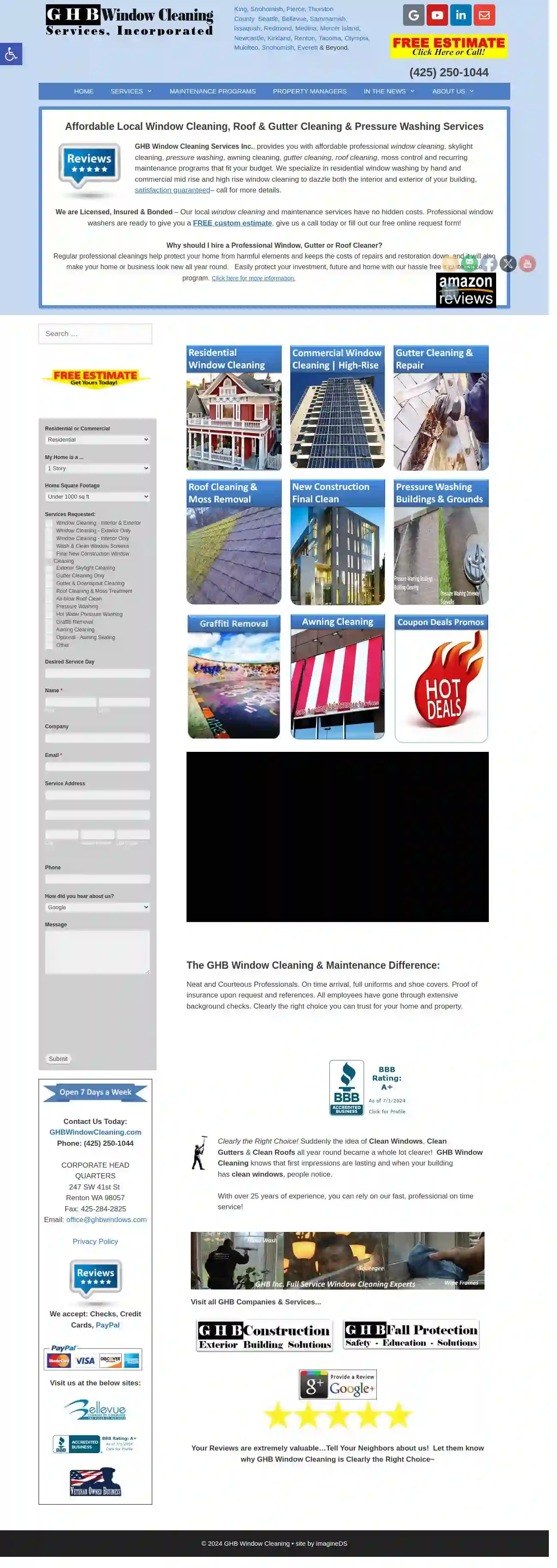Window Cleaning Silver Firs
Top Residential Window Washing in Silver Firs
Receive 3 FREE Window Washing quotes for your project today! Compare profiles, reviews, accreditations, portfolio, etc... and choose the best service.

Fish Window Cleaning
4.930 reviews2721 N. Van Marter Rd. Suite #5, Spokane Valley, 99206, USOwner: Greg Nixon Serving: Spokane, Spokane Valley, Millwood, Dartford, Orchard Prairie, WA We're located at: 2721 N. Van Marter Rd. Suite #5, Spokane Valley WA 99206 (509) 919-3138 Welcome to Fish Window Cleaning Spokane! We are your local residential and commercial window cleaning company serving Spokane, Spokane Valley, Millwood, Dartford, and Orchard Prairie, WA. Contact us today for your free on-site estimate! (509) 919-3138 We provide commercial and residential window cleaning services to Spokane, Spokane Valley, Millwood, Dartford, and Orchard Prairie, as well as these additional services: Storm Window Cleaning Screen Cleaning Sill Cleaning Skylight Cleaning Chandelier Cleaning Light Fixture Cleaning Mirror Cleaning Construction Clean-Up Gutter Cleaning Take a look at what some of our customers are saying about our services! Your Home We understand that you want your home to look its best but sometimes there just isn't enough time to check everything off your to-do list. Let Fish Window Cleaning take care of some of those time consuming tasks for you! We can clean all of your home's windows inside and out - including the hard-to-reach ones - quickly and quietly so you can just sit back and enjoy your free time. Our team is professional, friendly, and respectful of your home. We wear clean shoe covers and use absorbent cloth pads under your windows as we clean to protect your floors. We are also licensed, bonded, and insured. We are committed to your satisfaction so let us show you the difference clean windows can make in your home! "Thank you for a very prompt & professional job that you did cleaning my gutters & with snow on the roof, besides! I will certainly use you again in the Spring or whenever I need you. Thanks for a job well done." - Larry Your Business Your windows are probably one of the first things your customers see when they arrive to your business. Let us help you make a great first impression with sparkling clean windows all year long! Whether your business is a restaurant, a store, an office, a church, or any other commercial building, we can put together a program tailored to your needs, budget, and schedule. Our window cleaners are licensed, bonded, and insured, and trained to provide only the highest quality service. You can rely on Fish Window Cleaning take care of the appearance of your business so you have one less task on your mind! "Zack & Devin were very professional and very friendly. Great guys, great job done." - Erin and Scott Fish Window Cleaning services the following zip codes in Spokane, Spokane Valley, Millwood, Dartford, and Orchard Prairie, WA: 99202, 99251, 99212, 99218, 99206, 99216, 99207, 99204, 99201, 99217, 99205, 99208
- Services
- Why Us?
- Our Team
- Testimonials
- Gallery
Get Quote
360 Window Cleaning Inc
27714 Shriver ave, Bonita Springs, 34135, US360 Window Cleaning Inc is a detail-oriented window cleaning team with years of experience making glass look its absolute best. We love serving our community here in Naples, and we work harder than anyone to ensure our customers get the first-class treatment they deserve. If you ever need a professional window cleaning company to care for your windows and get your glass to look better than ever, 360 Window Cleaning Inc is here to serve you! 360 Window Cleaning Inc isn't just any window cleaning company; we're a crew of local professionals who pride themselves on consistently achieving the most spectacular results. Our experienced staff uses the latest and most trusted in window cleaning tools and solutions, and there isn't a surface in this state that we can't restore to its original beauty. When you call on 360 Window Cleaning Inc for your window cleaning needs, you'll get licensed and insured experts who provide specialized services on a flexible schedule. Our team members will clean and care for your property with the same precision and care as if it were our own, and we're always willing to customize any of our services to meet your specific needs.
- Services
- Why Us?
- Accreditations
- Testimonials
- Gallery
Get Quote
GHB Window Cleaning Inc
56 reviews247 SW 41st St, Renton, 98057, USGHB Window Cleaning Services Inc. is a locally owned and operated company that has been providing professional window cleaning, skylight cleaning, pressure washing, awning cleaning, gutter cleaning, roof cleaning, moss control and recurring maintenance programs for over 25 years. We specialize in both residential and commercial window cleaning, with a focus on providing affordable and reliable services. Our team of neat and courteous professionals arrives on time in full uniforms and shoe covers, and we are fully insured and bonded. We also conduct extensive background checks on all employees. GHB Window Cleaning is committed to providing a hassle-free experience for our clients, and we guarantee satisfaction on all of our services.
- Services
- Why Us?
- Gallery
Get Quote
Miguels Home and Commercial Services, LLC.
514 reviewsPO Box 366732, Bonita Springs, 34136, USMiguel's Home Services is your one-stop shop for all your home and commercial cleaning needs. We offer a wide range of services, including property maintenance, pressure washing, gutter cleaning, dryer vent cleaning, window cleaning, and janitorial services for associations and commercial properties. We are committed to providing our clients with the highest quality service at competitive prices. Our team of experienced professionals is dedicated to exceeding your expectations.
- Services
- Why Us?
- Gallery
Get Quote
Gleaming Glass Window Cleaning
527 reviewsNine Mile Falls, WA, 5919 Hwy 291 Ste 1 #248, 99026, USGleaming Glass is your local choice for residential and commercial Spokane window cleaners serving the needs of Spokane County and all surrounding areas. We expertly clean all types of residential and commercial windows with complete knowledge and expertise. We also do Moss Removal and clean roofs, gutters, eaves and much, much more. Our experience and attention to detail set us apart from our competition. We are licensed, bonded and insured and have earned a reputation for excellence. We pride ourselves on having consistent outstanding customer service, unparalleled attention to detail and the window cleaning expertise that has made us a local leader. Our dedication to customer satisfaction has always been the key to our success. One call to our company, and you’ll see how our experience makes the difference between good work and excellent work. Gleaming Glass has been in business since 2007 and word of mouth referrals have kept us growing rapidly. People continually compliment us on our quality of work, professionalism, and value. Whether you want a home or commercial space cleaned, Gleaming Glass will leave your windows shining! Locally Owned & Operated As a locally owned and operated business here in Spokane County, every one of our customers is extremely valued. It is our goal to earn your trust and keep your business for years to come.
- Services
- Why Us?
- Testimonials
- Gallery
Get Quote
Skyscraper Window Cleaning
4.954 reviews600 1st Avenue, Seattle, 98104, USSkyscraper Window Cleaning is a Seattle-based company dedicated to providing top-quality window cleaning services for both commercial and residential buildings. Our primary goal is to exceed customer expectations by delivering exceptional results and ensuring their complete satisfaction. We understand the importance of maintaining clean and pristine windows for commercial buildings, which is why we utilize the most advanced equipment available. Our preferred method is the self-climbing HighRise™ window cleaning system. This innovative system not only leaves windows spotless but also cleans the entire building, extending its lifespan. We chose this self-contained machine due to its numerous benefits for our customers. It allows us to start work from the top of the building, saving valuable time and completing all necessary cleaning tasks in a single day. Our experienced technicians are proficient in its remote control operation, ensuring efficient and precise cleaning. This approach not only saves our customers money but also guarantees perfectly clean windows. Furthermore, the HighRise™ system minimizes the risk of scratches and damage, ensuring the safety and integrity of your building's exterior.
- Services
- Why Us?
- Gallery
Get Quote
Kelian - Cleaning Services
525 reviewsSeattle, USKelian Cleaning Services is a family-owned business dedicated to providing exceptional cleaning services and building trust with our customers. Our primary goal is to ensure complete customer satisfaction with every job we undertake. We offer a wide range of high-quality services, including window cleaning, gutter cleaning, roof cleaning, solar panel cleaning, and pressure washing, serving Seattle, WA, and the surrounding areas. We pride ourselves on our commitment to excellence, utilizing the latest equipment and industry best practices to deliver outstanding results. Our team is professional, reliable, and always strives to exceed expectations. Whether you need a one-time cleaning or ongoing maintenance, Kelian Cleaning Services is your trusted partner for all your exterior cleaning needs.
- Services
- Why Us?
- Our Team
- Testimonials
- Gallery
Get Quote
Renova Exteriors
4.9214 reviews1705 S. 93rd Street, Suite F8, 1705 S. 93rd Street | Suite F8, Seattle, 98108, USRenova Exteriors is a locally owned and operated business serving the greater Seattle area. We specialize in exterior detailing and lighting services, helping homeowners keep their properties looking their best year-round. Our mission is to renew, restore, and revive your home's exterior, using industry-best detailing equipment and eco-friendly green products. We stand behind the quality of our work with a 100% satisfaction guarantee. We understand the stress that comes with a dirty home, from the anxiety of last-minute cleaning before guests arrive to the nagging thought of your mother-in-law commenting on your roof moss. We believe a clean home is a happy home, and we're here to help you achieve that. Whether it's dirty windows, roof moss, or unsightly sidewalks, we've got you covered. Our team of experienced professionals is dedicated to providing exceptional service and exceeding your expectations. We offer a wide range of services, including window washing, pressure washing, gutter cleaning, roof cleaning and moss removal, solar panel cleaning, and holiday lighting. Ready to tackle your to-do list? Here's how it works: Fill out our easy intake form Receive a custom itemized quote Select your preferred Renova service package Schedule, sit back, and relax! Contact us today for a free quote and let us help you restore your property to its former glory!
- Services
- Why Us?
- Our Team
- Gallery
Get Quote
Spic 'N Span Pressure Washing & Window Cleaning
526 reviewsNaples, FL, 123 Main St, 34103, USAt Spic ‘N Span Cleaning, our number one goal is customer satisfaction. When you hire us for pressure washing services, you get a professional who ensures the job is done just the way you want. Certified in pressure cleaning services allows us to provide roof cleaning, house power wash or driveway pressure cleaning using the best techniques. All the power washing services offered by Spic ‘N Span Pressure Washing & Window Cleaning are tailored to meet the needs of local residents and business owners in Collier County and Lee County. Our commitment ensures your home or commercial property will be clean and looking its best.
- Services
- Why Us?
- Accreditations
- Our Team
- Testimonials
- Gallery
Get Quote
Ren's Window Cleaning LLC
54 reviewsSpokane, USREN'S WINDOW CLEANING Serving WESTERN & EASTERN WA homes & businesses since 2021 We are a professional window cleaning company dedicated to providing high-quality service at affordable prices. We understand that clean windows make a big difference in the appearance of your home or business, and we are committed to exceeding your expectations. Our team of experienced and reliable cleaners will work hard to ensure that your windows are sparkling clean. We offer a wide range of window cleaning services, including residential and commercial window cleaning, exterior and interior window cleaning, track and screen cleaning, gutter cleaning, roof cleaning, pressure and soft washing, screen repair and replacement, solar panel cleaning, and winter and holiday services. We are fully insured and bonded, so you can be confident that your property is in good hands. We also offer free estimates. Contact us today to schedule your free estimate!
- Services
- Why Us?
- Gallery
Get Quote
Over 60,241+ Cleaning Contractors registered
Our janitorial services operate in Silver Firs & surroundings!
CleaningMatch has curated and vetted the Best Cleaning Services arround Silver Firs. Find a top & trustworthy business today.
Frequently Asked Questions About Window Cleaning
- Ask Directly: When requesting quotes or contacting the company, ask directly if they have liability insurance and workers' compensation insurance.
- Check Their Website: Many reputable window cleaning companies will prominently display their insurance information on their website.
- Request Proof of Insurance: Don't hesitate to request a copy of their insurance certificate for verification. This document outlines their coverage and policy details.
- Online Reviews: Check online reviews and ratings on platforms like Google, Yelp, and Trustpilot to get an idea of customer satisfaction and service quality.
- Experience: Look for companies with a proven track record and experience in the industry. Experience often translates to better techniques and results.
- Licensing and Insurance: Ensure the company is properly licensed and insured. This protects you from liability in case of accidents or damage.
- Quotes and Pricing: Get quotes from multiple companies to compare pricing. Ensure the quotes are detailed and transparent, outlining all services and costs.
- Professionalism: Choose a company that is responsive to inquiries, provides clear communication, and demonstrates professionalism in their interactions.
- Squeegees: A T-shaped tool with a rubber blade, used to remove cleaning solution from the glass, leaving a streak-free finish.
- Microfiber Cloths: Soft, lint-free cloths that are highly effective at cleaning glass without scratching.
- Buckets: Used to hold cleaning solutions and rinse water.
- Spray Bottles: Used to apply cleaning solutions to windows.
- Scrapers: Used to remove stubborn dirt, paint splatters, or stickers from windows.
- Extension Poles: Extend the reach of squeegees and brushes, allowing cleaners to reach high windows without ladders.
- Water-Fed Pole Systems: Use purified water and a telescopic pole with a brush head to clean windows from the ground.
- Clean on a Cloudy Day: Direct sunlight can cause the cleaning solution to dry too quickly, leaving streaks. Cleaning windows on a cloudy day or in the shade is best.
- Use the Right Tools: Microfiber cloths are ideal for cleaning glass as they are lint-free. Squeegees are also effective for removing cleaning solution without streaks.
- Clean from Top to Bottom: Start cleaning from the top of the window and work your way down to prevent drips from causing streaks on already cleaned areas.
- Overlap Squeegee Strokes: When using a squeegee, overlap each stroke slightly to ensure complete coverage and prevent streaks.
- Wipe the Squeegee Blade: Wipe the squeegee blade clean after each stroke to remove dirt and moisture that can cause streaks.
How can I tell if a window cleaning company is insured?
A reputable and responsible window cleaning company will be transparent about their insurance coverage, providing peace of mind for their clients.
How do I find a reputable window cleaning service?
Platforms like CleaningMatch can help you find and compare reputable window cleaning services in your area.
What are some common window cleaning tools?
These specialized tools, combined with professional techniques, ensure efficient and effective window cleaning results.
What are some tips for cleaning windows without streaks?
With practice and the right technique, you can achieve streak-free windows and enjoy crystal clear views.
How can I tell if a window cleaning company is insured?
- Ask Directly: When requesting quotes or contacting the company, ask directly if they have liability insurance and workers' compensation insurance.
- Check Their Website: Many reputable window cleaning companies will prominently display their insurance information on their website.
- Request Proof of Insurance: Don't hesitate to request a copy of their insurance certificate for verification. This document outlines their coverage and policy details.
A reputable and responsible window cleaning company will be transparent about their insurance coverage, providing peace of mind for their clients.
How do I find a reputable window cleaning service?
- Online Reviews: Check online reviews and ratings on platforms like Google, Yelp, and Trustpilot to get an idea of customer satisfaction and service quality.
- Experience: Look for companies with a proven track record and experience in the industry. Experience often translates to better techniques and results.
- Licensing and Insurance: Ensure the company is properly licensed and insured. This protects you from liability in case of accidents or damage.
- Quotes and Pricing: Get quotes from multiple companies to compare pricing. Ensure the quotes are detailed and transparent, outlining all services and costs.
- Professionalism: Choose a company that is responsive to inquiries, provides clear communication, and demonstrates professionalism in their interactions.
Platforms like CleaningMatch can help you find and compare reputable window cleaning services in your area.
What are some common window cleaning tools?
- Squeegees: A T-shaped tool with a rubber blade, used to remove cleaning solution from the glass, leaving a streak-free finish.
- Microfiber Cloths: Soft, lint-free cloths that are highly effective at cleaning glass without scratching.
- Buckets: Used to hold cleaning solutions and rinse water.
- Spray Bottles: Used to apply cleaning solutions to windows.
- Scrapers: Used to remove stubborn dirt, paint splatters, or stickers from windows.
- Extension Poles: Extend the reach of squeegees and brushes, allowing cleaners to reach high windows without ladders.
- Water-Fed Pole Systems: Use purified water and a telescopic pole with a brush head to clean windows from the ground.
These specialized tools, combined with professional techniques, ensure efficient and effective window cleaning results.
What are some tips for cleaning windows without streaks?
- Clean on a Cloudy Day: Direct sunlight can cause the cleaning solution to dry too quickly, leaving streaks. Cleaning windows on a cloudy day or in the shade is best.
- Use the Right Tools: Microfiber cloths are ideal for cleaning glass as they are lint-free. Squeegees are also effective for removing cleaning solution without streaks.
- Clean from Top to Bottom: Start cleaning from the top of the window and work your way down to prevent drips from causing streaks on already cleaned areas.
- Overlap Squeegee Strokes: When using a squeegee, overlap each stroke slightly to ensure complete coverage and prevent streaks.
- Wipe the Squeegee Blade: Wipe the squeegee blade clean after each stroke to remove dirt and moisture that can cause streaks.
With practice and the right technique, you can achieve streak-free windows and enjoy crystal clear views.